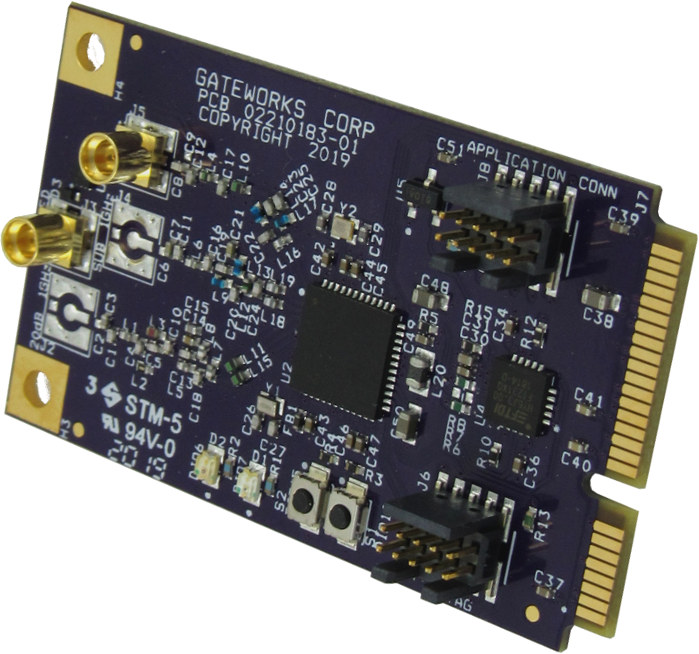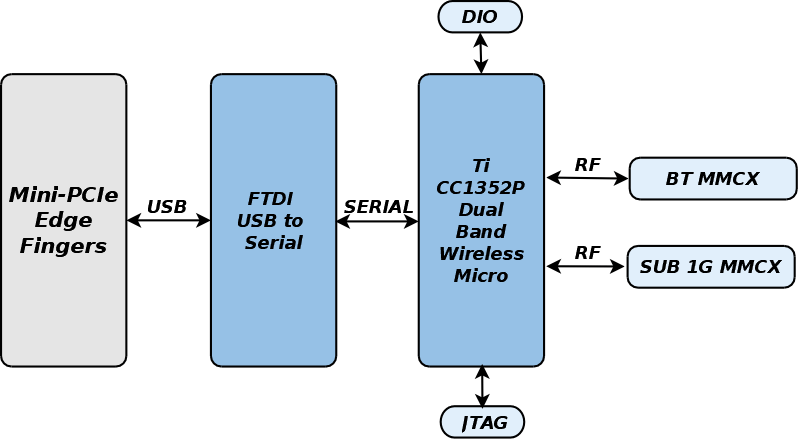Gateworks GW16122 is a mini PCIe card that adds sub-GHz and 2.4GHz radio to the company line of Ventana and Newport Linux SBC’s, and is meant for industrial IoT (IIoT) applications as an alternative to LoRa and Sigfox.
The second generation of the card is based on Texas instruments CC1352P dual-band wireless SoC that supports Wireless M-Bus, IEEE 802.15.4g, 6LoWPAN, KNX RF, and Wi-SUN at sub-GHz frequencies (EU: 868MHz, US: 915MHz), and Bluetooth 5 Low Energy, Thread, and Zigbee at 2.4 GHz.
 Gateworks GW16122 key features and specifications:
Gateworks GW16122 key features and specifications:
- MCU – Texas Instruments CC1352P Arm Cortex-M4F MCU @ 48 MHz with 352KB flash, 80KB SRAM, dual-band wireless radio transmitter/receiver
- Radios
- Sub-1 GHz Radio
- 868MHz EU, 915 MHz US (default)
- Low Power, sensor nodes can run on a coin-cell battery
- -121dBm Receive Sensitivity for long-range communication
- 20dBm Output Power
- Texas Instruments TI-RTOS and TI-15.4 Stack
- M-Bus, IEEE802.15.4g, Contiki 6LoWPAN, Wi-SUN, KNX RF standards
- Data rate – 1Kbps to 250Kbps typ.
- 2.4 GHz RF Output Supports:
- Bluetooth 5 with LE Coded Phy Support
- Thread, Zigbee
- Sub-1 GHz Radio
- Expansion – Analog, I2C, and Digital I/O application connector
- Debugging – 10-pin JTAG connector
- Host Interface – mini PCIe edge connector with USB signals
- Power Supply – 3.3V via mini PCIe connector; 0.25A typical operating current
- Dimensions – 30.0×60.8×11.5mm
- Weight – 5.7 grams
- Temperature Range – -40C to +85°C
 The mini PCIe card is said to be compatible with Texas Instruments LaunchPad LAUNCHXL-CC1352P development kit, and the company recommends Ventana GW5913 or GW5910 SBC as a host to create IoT gateways for embedded rugged and industrial applications.
The mini PCIe card is said to be compatible with Texas Instruments LaunchPad LAUNCHXL-CC1352P development kit, and the company recommends Ventana GW5913 or GW5910 SBC as a host to create IoT gateways for embedded rugged and industrial applications.
The second generation of GW16122 mini PCIe cards has been made to improve features and reduce the price thanks to an updated TI CC1352P wireless MCU (instead of CC1350) with increased flash storage and SRAM, improved output power, and the removal of a large TI Tiva MCU.
The company also highlights that compared to other LPWAN IoT technologies such as SigFox and Lora, there are no monthly fees nor consortium memberships, all the software is open-source, and the entire network is completely private. The company tested the range of the first generation card with a 2dBi omni-antenna on the 915Mhz band and transmitted data over a 1.4km distance with both the transmitter and receiver at around 1 meter above the ground. With a directional antenna, the range can be increased further with links easily greater than 10km, and the increased Tx power of the second generation card can help further increase the range. You’ll find more details on the Wiki.
Gateworks GW16122 is available now, but the price is not public, and instead, you’d need to request a quote via the product page.

Jean-Luc started CNX Software in 2010 as a part-time endeavor, before quitting his job as a software engineering manager, and starting to write daily news, and reviews full time later in 2011.
Support CNX Software! Donate via cryptocurrencies, become a Patron on Patreon, or purchase goods on Amazon or Aliexpress





Another proprietary standard?
I don’t think so and I see it differently. It will likely not succeed precisely because instead of supporting *one* technology, it instead aims at being compatible with everything, meaning that nobody will settle around a standard solution and everyone will implement something different, causing a massive fragmentation of any ecosystem initiative.